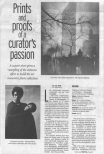Prints and proofs of a curator’s passion
The Oregonian, Portland, Oregon
July 17, 2002
Like skyscrapers, museum collections are not built overnight.
Ask Terry Toedtemeier, the Portland Art Museum’s curator of photography. In the course of 19 years, Toedtemeier has built the museum’s photography collection from a few dozen pieces to what he now estimates is a trove of several thousand prints. It’s been a herculean effort that’s even more impressive because Toedtemeier has been working at the museum part time and without a budget to buy photographs.
A sampling of Toedtemeier’s recent labors is on view now at the museum with “Shaping a Collection: Recent Contributions – Photographs From the Permanent Collection,” an exhibit of 91 recently acquired never before seen here.
It’s a superb, diverse show that spans the better part of the past century and features works by such historically important photographers as Dorothea Lang, Ruth Bernhard, Ansel Adams, Garry Winogrand and Gilles Peress and a slew of regionally prominent ones such as Stu Levy, Susan Seubert and Thomas Miller.
The show is also noteworthy because it’s the first to feature several works acquired with the help of the museum’s Photography Council. Established 13 months ago and composed of about three dozen prominent members from the local photography community (members include Levy, dealer Steven Josefsberg and photographer Christopher Rauschenberg) the council has the sole purpose of advancing the photography collection and the photographic medium.
Still, even with organizational support, building a collection takes time. Toedtemeier says that only a small number of the prints on view came courtesy of the council. Most arrived in the tried-and-true manner used by most curators with little money at their disposal: guile, gentle cajoling of collectors, and bequests and donations from longtime supporters whom Toedtemeier impishly describes as “folks who were just nice to the museum.”
The show spans an extraordinary range of time and covers a spectrum of human experience, touching upon almost every human endeavor under the sun: the ravages of war, American social politics during the 20th century, the emergence of New York as a metropolis, an inside look at Hitler’s Third Reich, and, of course the physical glories of nature.
On view, for example, is Lange’s famous Depression-era photograph “Migrant Mother,” as well as Gordon Parks’ equally iconic and burnished image from 1942, “American Gothic,” which features an African American woman holding a broom and a mop with an unfurled U.S. flag in the background. There are several fine Photo-secessionist works: Edward Steichen’s photo of New York’s Flatiron Building and Karl Struss’ “Brooklyn Bridge, Nocturne,” two images that also capture in soft-focus romanticism the emerging New York metropolis.
In other words, the exhibit’s visual pleasures are endless. You can’t go wrong with any photograph. But a good way to navigate through the show is to go beyond the big works we’d expect the museum to acquire and look for the unexpected gems by esteemed photographers or works by those we don’t know much about. Or just look for Toedtemeier’s fascinating parings of photographs.
There’s a trio of fantastic works from Winogrand, one of the finest post-World War II lensmen but whose brand of New York-based street photography is considered old school today. His “Women Are Beautiful” series consists of some of the most unabashedly frank poetic appreciations of women put on film by a male photographer.
The museum ahs about a dozen works by Imogen Cunningham, a member of the seminal 1930’s-era “Group f/64″ group of photographers and also a former student at the University of Washington. In the show, Toedtemeier has paired an early (circa 1910) self-portrait with Alan Ross’ print of a much older Cunningham. It’s a contrast between young and old, past and future, and also of styles: Cunningham’s youthful self-portrait seems like a flickering candle compared with Ross’ clearer-focused portrait of a line-creased Cunningham.
Some of the most compelling photographs in the show are by Erika Schmauss, a German photographer who seems to have had unusual access to the inner workings of the Third Reich. Her tiny, stamp-sized photographs of Hitler Youth and sleek, menacingly beautiful, Albert Speer-designed architecture are themselves physical embodiments of aesthetic discipline and authority.
There is a bounty of landscape photographs – prints by Ansel Adams, Lois Conner, Edward Weston and an especially marvelous one by Chip Hooper. In a photograph of a large rock formation on the beach, Hooper’s long exposure time literally evaporates the horizon line creating the illusion of a rock floating in black space.
Ultimately, every collection is made, in part, in the image of the curator assembling it. And if a single vision unifies these incredibly diverse works, it’s the 55-year old Toedtemeier’s, whose interests run the gamut from science to history. He also happens to be one of the country’s best landscape photographers working today.
So, what attracted Toedtemeier to these many different pictures?
” It’s all about beauty in the end,” he says.
